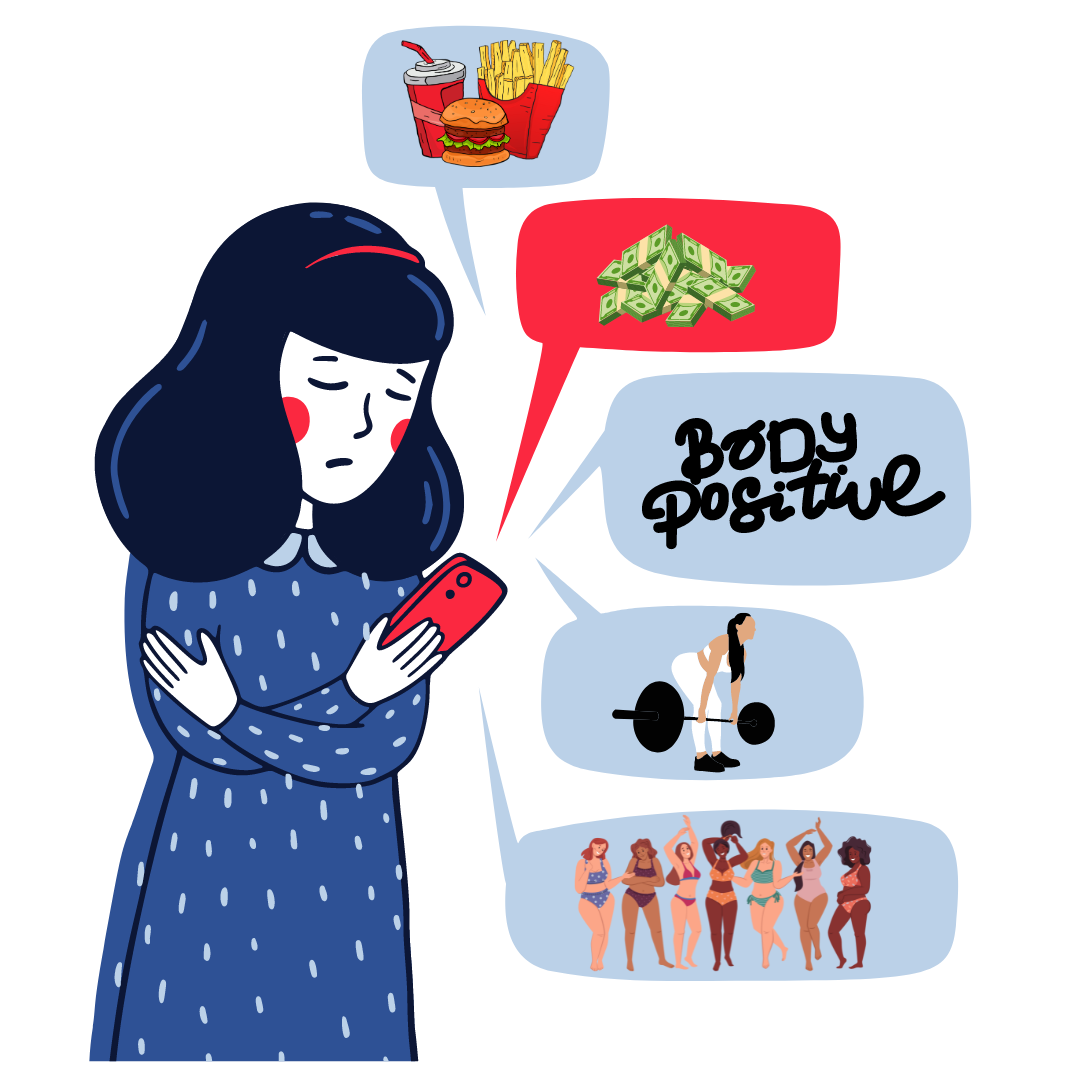According to today’s standards, if you always eat a salad for lunch and go to the gym three times a week, you are honoring your body.
Similarly, if you eat McDonald’s every day for dinner and do minimal exercise, you are also honoring your body.
These are essentially the two sides of the current body positive movement: some body positive influencers strive to motivate people to eat healthy, nutritious meals and exercise for at least some time every day, but other body positive influencers also encourage honoring what your body craves and not worrying about other people’s opinions.
In theory these are both idealistic ways of living, but in reality neither side benefits the individual. One extreme is not better than the other—an intensely healthy and restrictive lifestyle is no better than an unhealthy and carefree lifestyle.
While the two sides of the movement might seem to be polar opposites, they do share one prominent characteristic: the emphasis on consumerism.
Both sides of the movement place attention on unnecessary products and programs, and convince viewers that the items influencers have on screen are vital to achieving the empyrean promise of self-love.
The side of the movement that centers itself around a “healthy” lifestyle promotes gym memberships, beauty products such as moisturizer and makeup and buying healthier but more expensive groceries. A majority of influencers record videos that often feature time spent working out, whether in a gym, in a pool or on a run, most of the time dressed in brightly colored workout sets and sleek headphones.
In fact, the impact of the “gym trend” has resulted in an increase in gym memberships since 2012, when the body positivity movement is considered to have first begun. Memberships rose from 50.2 million in 2012 to 64.2 million in 2019, and the number of memberships in 2021 increased by 3.6% from before the pandemic.
Additionally, the movement’s priority of healthy food has also led to a changed attitude in the lives of Americans.
A study conducted by Statista Consumer Insights found that around 50% of Americans are trying to eat more healthily, but another survey by the Cleveland Clinic found that 46% of adults considered money as a barrier to healthier foods.
The problem with this mindset is that it can lead to a more restrictive lifestyle. A healthy diet can just as easily turn into eating only fruit and vegetables for fear of eating “unhealthily,” and working out can become obsessive.
The opposite is true for the other side of the movement, which argues that all bodies are beautiful and do not need to be changed for self-acceptance.
Influencers of this kind often post videos of themselves with body positive captions or themes, reminding viewers that there is nothing wrong with not fitting in with the beauty standards the media tries to promote.
This alone would not be a problem, but some influencers glorify unhealthy habits, such as eating fast food during every meal and rarely working out.
According to a study conducted by the Centers for Disease Control and Prevention (CDC), over 36.3% of children aged two to 19 years old consumed fast food on a regular basis. Moreover, another study the CDC conducted found that in 2022, 22 states at least 35% of adults in the U.S. had obesity, an increase from 2021, in which 19 states had a 35% obesity rate.
While this might not be because of the message of this part of the body positivity movement, the movement still encourages actions that could lead to obesity if there is not proper guidance and support.
Unhealthy eating habits are not the only flaw in this movement; clothing companies have begun to release more inclusive sizing ranges and market with more diverse models.
On the surface level, this seems like a positive thing, but it does not solve the deeper issue concerning body image in the United States. By pushing to include all bodies in fashion, companies are showing consumers that “buying stuff is the way to deal with insecurities generated by narrow appearance standards,” anthropologist Jamie E. Shenton wrote in a 2022 article.
Body positivity at its core is a movement with good intentions, but it does not fulfill the needs of younger generations.
We still live in a society where appearance is arguably valued more than character and the emphasis on the physical aspect of people is only fueled stronger by social media and consumerism.
In order to properly alter society’s ideas, we need to instead remove the concept of body positivity from being so heavily influenced by consumerism and capitalism.
You can accept and learn to love your body without that protein-packed salad, without that workout set that influencers say looks good on everyone, without that packet of cookies, without clothes that you’ve been told are perfect for your body type.
Money will not give you a happier relationship with your body; only you can.
